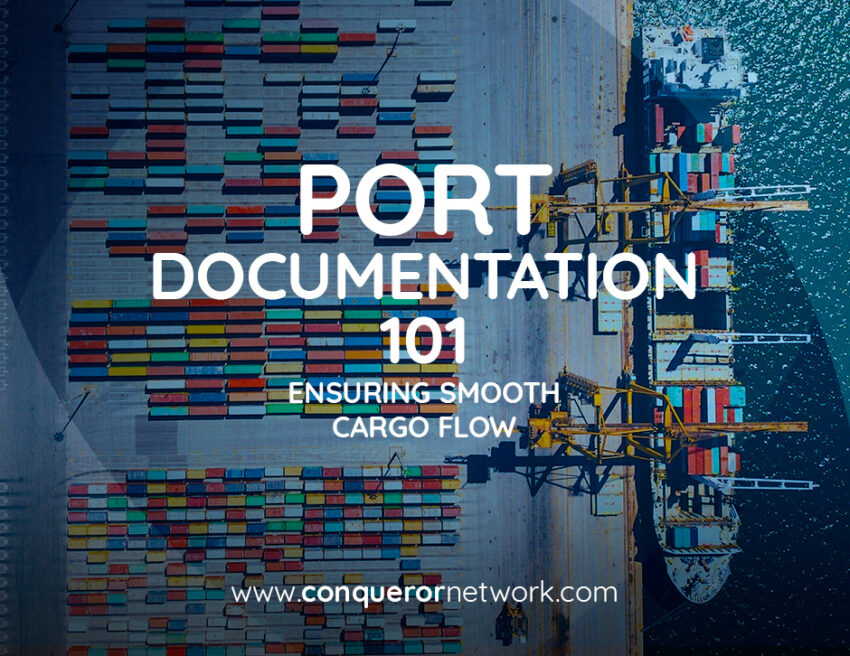Ever wondered how a single missing document can derail an entire international shipment? A delayed shipment can ripple through the supply chain, impacting production schedules, retail shelves, and customer satisfaction. And more often than not, these delays can be traced back to one culprit: incorrect or incomplete port documentation. For sea freight forwarders, port documentation is one of the most critical aspects of cargo handling. It’s the paperwork that unlocks the gates—literally. Without it, cargo sits idle in containers at ports, racking up demurrage charges and wasting valuable time. Documentation errors can bring the entire flow of goods to a grinding halt in a system where efficiency is everything.
This blog aims to guide sea freight forwarders through the essentials of port-related paperwork, highlight the most common mistakes, and provide strategies to streamline the documentation process. If you work in sea freight logistics, mastering port documentation is not just a skill—it’s a competitive advantage.
The importance of documentation in sea freight logistics
In sea freight logistics, shipping documentation serves multiple purposes. It facilitates customs clearance, ensures cargo is correctly identified, validates ownership, and enables port authorities to release goods. From a legal standpoint, the paperwork becomes a contractual chain linking buyers, sellers, shippers, and carriers.
Documents such as the Bill of Lading, Commercial Invoice, Packing List, Certificate of Origin, and Import/Export Licenses are more than just formalities. They ensure that cargo complies with international regulations and reaches its final destination on time and without penalties. Mistakes in any of these documents can cause serious setbacks, including cargo holds, fines, and even seizure by customs. With the rise of digital freight systems and stricter international regulations, documentation has become even more complex—and even more crucial.

Common mistakes in port documentation made by sea freight forwarders
Despite the importance of documentation, errors continue to plague the shipping process. These mistakes may seem small, but their impact on the supply chain can be enormous. One of the most frequent errors made by sea freight forwarders is incorrect or inconsistent shipment details. Discrepancies between the Bill of Lading and the Commercial Invoice—such as mismatched cargo descriptions, weights, or consignee names—can trigger red flags with customs and delay cargo release.
Another common issue is late submission of documents. In the high-volume environment of global ports, submitting paperwork after the cut-off time can delay container loading or discharge, especially when shipping lines require pre-clearance before arrival.
Documentation also suffers from over-complexity. Sea freight forwarders sometimes duplicate information across multiple forms without standardizing the data. This inconsistency not only wastes time but increases the risk of data entry errors, which can spiral into costly delays.
Incorrect or missing Harmonized System (HS) codes are another pitfall. HS codes are essential for determining duties and taxes, and using the wrong one can result in incorrect tariff applications—or worse, legal violations. Customs authorities in many countries take HS code violations seriously, especially for controlled or high-value goods.
Finally, there’s the issue of incomplete or missing supporting documents. In sea freight shipments involving food, electronics, or chemicals, you often need certificates of compliance, fumigation reports, or safety data sheets. Missing these documents can halt a shipment regardless of how well-prepared the core documents are.
Understanding key documents for port clearance
To ensure smooth cargo flow through ports, it’s essential to understand the role of each document in sea freight logistics. The Bill of Lading is arguably the most important—it’s a transport contract, cargo receipt, and title document all in one. Errors in this document can jeopardize ownership claims and payment terms.
The Commercial Invoice provides details about the transaction value and cargo description and is used by customs to calculate duties. It must match the Packing List, which outlines the contents of each container. A mismatch here often results in physical inspection, delaying clearance.
The Certificate of Origin establishes where the goods are manufactured and affects tariff rates in many trade agreements. Getting this document authenticated or notarized, if required, is vital.
Import and Export Licenses depend on local regulations. Countries like China, India, and the United States enforce strict licensing protocols for certain categories of goods, including electronics, pharmaceuticals, and military-use items.
Each of these documents must be accurate, synchronized, and submitted in line with port and carrier deadlines. Even experienced freight forwarders in sea freight logistics occasionally overlook small details, leading to costly outcomes.
How to streamline port documentation in sea freight logistics
The good news is that many of the challenges related to documentation can be mitigated with better processes and smarter tools. The first step toward improving port paperwork is standardization. Freight forwarders should implement standardized templates for invoices, packing lists, and bills of lading, reducing inconsistencies and improving data accuracy.
Another key strategy is document digitization. Today’s logistics software platforms offer integrated document management systems that sync shipment data across all required documents. This reduces the likelihood of discrepancies and speeds up document generation. E-document submission, now accepted in many major ports including Shanghai, Rotterdam, and Los Angeles, allows for real-time updates and smoother pre-arrival clearance.
Verification is another pillar of efficient documentation. Many forwarders now include a dedicated compliance check step before final document submission. This internal review—whether manual or AI-assisted—flags mismatches, errors, and missing data before documents reach customs.
Training is equally important. Many documentation mistakes occur simply because staff are unaware of the latest port regulations or specific client requirements. Conducting regular team training and maintaining a knowledge database can help avoid these pitfalls.
Collaboration also plays a role in streamlining. Forwarders should maintain strong communication with shippers, carriers, and customs brokers to ensure all documentation is prepared accurately and submitted on time. A well-coordinated chain of communication minimizes last-minute surprises.
Some forwarders also appoint a “documentation lead” for high-value or complex shipments. This person oversees the paperwork from start to finish, ensuring nothing slips through the cracks.
Documentation trends in modern sea freight logistics
As sea freight logistics continues to evolve, so does documentation. The industry is moving towards blockchain-based document sharing, electronic Bills of Lading (eB/L), and smart contracts. These innovations promise greater transparency, fewer errors, and faster clearance.
The International Group of P&I Clubs has already approved several eB/L platforms, and major shipping lines like Maersk and MSC are rolling out digital document protocols. Forwarders who adapt to these technologies will not only improve efficiency but also gain a competitive edge in the market.
Another trend is the integration of documentation into digital freight marketplaces. Platforms like Freightos, Flexport, and CargoWise now offer document syncing, reducing the manual workload for forwarders and eliminating duplication.
As the regulatory landscape gets tighter—especially with growing emphasis on sustainability, safety, and trade compliance—the role of correct documentation will only grow in importance.
Wrapping up: Better paperwork, better performance
In a world driven by tight schedules and tight margins, documentation isn’t just paperwork—it’s power. It has the ability to delay or accelerate shipments, damage or enhance relationships, and hurt or help your bottom line. In sea freight logistics, where each container can represent millions in value, there’s no room for mistakes.
Freight forwarders who master the art of documentation ensure that cargo moves seamlessly from origin to destination. By embracing standardization, digitization, verification, and training, you not only reduce delays but elevate your professionalism in the eyes of clients and partners.
As global trade becomes more complex and competitive, correct port documentation will remain the hidden engine that keeps everything moving. It’s not the flashiest part of freight forwarding—but it might just be the most important.


